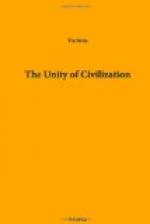And beside them stand the figures of women great and gracious, women for whose love men die and perish, but who themselves also can hate and love passionately and fiercely. It has sometimes been said by those who only know the epics in one or other of the various languages, that women and the love of women have no place in the epic, but belong to the romance, but this is a mistake. In the mediaeval epic there is little talk about emotion, but in the Nibelungenlied and in some of the Icelandic sagas the woman is, like Helen in the Homeric epic, the motive and source of all the action.
The epic is the story of great and heroic figures, abstracted in that sense from the common or ordinary circumstances of life, but the background of the action is always realistic and even detailed in its realism, so that, just as again in the Homeric poems, we can frequently reconstruct the life and manners of the time to which the poems belong from that which they tell us. And it is impossible to say that there is any really national difference between the epics as we find them in different languages; they are indeed the expression of the temperament and personality of the great artists who produced them, and they are each unique and individual in proportion to the greatness of their authors, but in their general characteristics they are the same.
There are few changes in the history of literature more remarkable than that which came over European art in the later years of the eleventh century and the beginning of the twelfth. The epic is concerned with the world of action, the romance is occupied almost exclusively with the world of feeling and emotion. For this is the real character of the romance. It has sometimes been said that the essence of the romance lies in the strange and mysterious circumstances of the world, in stories of mystery and wonder, of fairyland and magic. And it is quite true that it often uses these forms of human experience. But this is not its real quality. From the story of Tristan and the ‘lais’ of Mary of France, down to the Vita Nuova of Dante, that with which it is occupied is the human heart, its hopes and fears, its joys and sorrows, its exultation and despair. We have only to read the earliest and greatest forms in which the story of Tristan and Iseult have come down to us to see this for ourselves. It is indeed true that we can see or that we can conjecture that behind the present romance there may have lain an epic story of the hero’s actions, but what we see now is nothing but the story of the ‘infinite passion’, the ‘infinite pain’ of the human heart. It is the story of their fatal love, of the passion which drives them out of the homes of men into the wilderness, the fatal passion which separation only makes deeper, which nothing can change, nothing can end, the story of a man and woman to whom the world is well lost for love. And if you wish to see the whole meaning of life as the romance actually understood it, you have but to turn again to that ‘lai’ of Mary of France, which tells us in a few lines how Tristan and Iseult, long parted, succeed in meeting in the forest for a few moments—meet and then part—and over it all there is nothing but a certain exquisite sentiment of love and pain, of love and tears.




